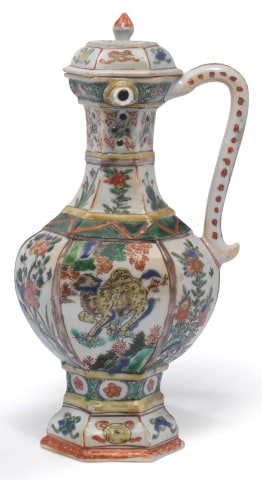BH67
Literature
This puzzle jug is of European form, probably based on a pottery original of the late 17th century.
Puzzle or trick vessels are known in European pottery at least as early as the 15th century. One of the earliest extant examples is an Italian maiolica bowl in the Wallace Collection, tentatively attributed to Deruta, circa 1480‑90, for which see Norman, Catalogue of Ceramics 1, C23. The present upright jug form is well known in English delftware from the middle of the seventeenth century. The earliest is dated to 1653, see Lipski and Archer, Dated English Delftware (1984) cat. no. 1009.
Puzzle jugs are also known in French faience and Dutch delftware. The latter appear to be later than English versions and perhaps derived from them. Fourest in his Delftware, p.136, no. 130, illustrates a puzzle jug made at the Old Moor's Head factory in the second half of the 18th century. In the footnote the author comments "This very common form was copied by the Chinese for the East India Company". The Chinese potter however, in this case, was not informed of the trick, and therefore made the handle solid.
There is a blue and white example in the collection of the Metropolitan Museum of Art, New York (Accession Number: 79.2.174). This example is dated to ca. 1710-1720. Similarly to ours, it is derived from an English original which was made in 1653, which was copied in Dutch Delft factories in the early 18th century. This Chinese blue and white model was made for the Dutch or English market.

